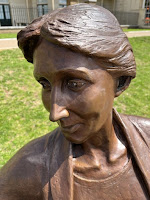Portrait of Tammi of Nazareth
"And I sayeth unto thee: Look upon mine eyes, which rest within mine head;
not upon mine bosom, wherein no wisdom dwells."
I. Truth, Justice, Mercy, and Peace
A friend of mine, who happens to be a specialist in medieval religious art and literature, recently gave birth to her third daughter and joked: 'I just need one more and God's people can be restored!' I sort of smiled at this, but, at the time, had no idea what on earth she meant by this.
However, after thinking about it - and doing a bit of biblical research - I realised that she was referring to Psalm 85 - and the so-called Four Daughters of God who loved nothing better than meeting up and exchanging kisses [1].
Of course, these four daughters were allegorical; they personified the virtues of Truth, Justice, Mercy, and Peace and their uniting in Love signified the triumph of God and the fact that mankind was forgiven its sins and redeemed by the sacrifice of Christ.
Attempts to pornify the motif - which was extremely popular in medieval Europe - by imagining scenes of incestuous lesbianism, are uncalled for, as the kisses were given in innocence [2]. At any rate, most people had become thoroughly bored with the idea by the end of the 17th-century, though some, like William Blake, remained fascinated by the Four Daughters.
II. Tammi of Nazareth
In September 2010, The Onion published a piece under the headline 'New Evidence Suggests God Also Had Incredibly Busty Daughter' [3], according to which:
"In a discovery that biblical scholars say could alter our most
fundamental understanding of Christianity, recently unearthed
manuscripts suggest that in addition to His Son, Jesus Christ, God also
had a daughter with absolutely humongous breasts."
The article goes on:
"The documents, found in a cave near the Jordanian-Israeli border and
estimated to have been composed circa A.D. 200, recount the life,
teachings, and death of Jesus' well-endowed twin sister, Tammi of
Nazareth."
And it continues in much the same comic-blasphemous (breast-obsessed) vein throughout.
It's juvenile, certainly, but it is also amusing to read that whilst Tammi "promulgated similar ideas as her sibling, and appeared to possess the same miraculous powers", she found it difficult to preach the gospel as followers were only interested in gaining "a better vantage point from which to observe her 'heavenly radiance'" hidden beneath a thin linen vestment.
III. Jane
Funny enough, Larry David anticipated this idea of a comely daughter born of God in a season 5 episode of Curb Your Enthusiasm, first broadcast in October 2005 ... [4]
In a now classic scene, Larry's Christian father-in-law (played by Paul Dooley) has purchased a nail used in the movie The Passion of the Christ (Mel Gibson, 2004) - not a film that Larry much cares for, wishes to watch, or discuss. And so he quickly changes the subject and takes the conversation in an irreverent (some might say sacrilegious) direction:
Larry David: 'You're nuts about this Jesus guy, aren't you?'
Cheryl's Father: 'Yeah. Well, I have a personal relationship with Christ.'
Larry
David: 'Really? See, I could see worshipping Jesus if he were a girl,
like if God had a daughter ... Jane. I'll worship a Jane. But, you know,
to worship a guy ... like a little kinda, you know, it's a little gay,
isn't it?'
Although his wife, Cheryl, attempts to shut him up at this point, Larry is determined to expand upon the idea:
Larry David: 'I would worship Jane, if he had a daughter Jane, I could have a relationship with a Jane.'
Cheryl's Father: [Increasingly annoyed and irritated] 'He didn't have a daughter!'
Larry David: 'It's a shame it wasn't a girl. That's all I have to say.'
Cheryl's Father: [Disgusted] 'Ugh!'
Larry David: 'Good looking woman ... Zaftig ... Good sense of humor ...'
Cheryl David: [Exasperated] 'Okay, that's fine.'
Larry David: 'If he had a daughter, everybody - everybody - would worship Jane. That's all I'm saying.'
It's an interesting point, as Jules would say.
And I think Larry is on to something: we don't need a pale and sickly looking Jesus with his crown of thorns - or even a weeping Virgin - for our saviour; we need a voluptuous woman who knows how to laugh (and make laugh) - more Marilyn than Mary [5].
Notes
[1] See Psalm 85:10 (KJV): "Mercy and Truth are met together; Righteousness and Peace have kissed each other."
This psalm is a community lament, probably written during the period of
Israel's return from Babylonian exile. The people seek forgiveness from God for their unfaithfulness and restoration of their former status and power. The closing section expresses confidence
that salvation will come.
[2] The Hebrew word for kiss in Psalm 85 doesn't refer to an erotic act per se, but, rather, to something exchanged by near relatives when greeting one another. In medieval Europe, where the visual motif of Justice and Peace kissing was first introduced, such an act was even more widespread than in the ancient Jewish world. However, because (male) artists have a penchant for nude (female) figures, renditions of Justice and Peace kissing were often (inappropriately) sexualised.
[3] 'New Evidence Suggests God Also Had Incredibly Busty Daughter', The Onion, (23 September, 2010): click here to read online.
[4] Curb Your Enthusiasm,
S5/E3, 'The Christ Nail' (2005), dir. Robert B. Weide, written by Larry
David. Click here to watch the scene on
YouTube.
[5] Thanks to the season 5 finale of Curb, we know that not only does Larry look forward to meeting Monroe in heaven, but that the latter is also a big fan of Seinfeld. See 'The End', S5/E10, dir. Larry Charles, written by Larry David, (2005). Marilyn is played in the episode by Susan Griffiths.




.jpg)

.jpg)


.jpg)


